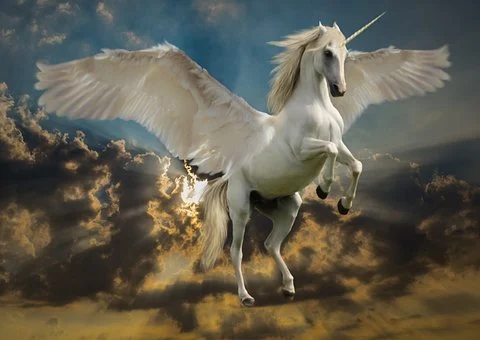A unicorn is a legendary creature with a single, large, pointed, spiraling horn on his forehead. It has been depicted in European literature and art as a white horse or goat-like animal with a long straight horn with spiral grooves, and sometimes a goat’s beard.
The unicorn was commonly described as a wild woodland creature in the middle ages and Renaissance. It is a symbol of purity and grace.

There was a belief that the horn of a unicorn has the power to cure sickness.
The unicorn is famous even today in popular culture. It is associated with fantasy.
History of Unicorn
Indus Valley Civilization
During the Bronze Age Indus Valley Civilization around 2000 BC, a single horn creature image was on the soapstone stamp seals. The body of the creature is more like a cow than a horse.
After the Indus valley civilization disappeared, the unicorn was not present in any art forms. People thought that the unicorn was the symbol of a powerful merchant community or clan. They also thought that it may have some religious significance.
Unicorns are not part of Greek mythology but a part of natural history. Greek writers believed that they lived in India which was a distant realm for them.
Ctesias wrote the book ‘Indika’ meaning ‘On India’ where he describes the Unicorn as wild asses with a horn. He got information about the creature while living in Persia. Unicorn on a relief culture was found in the ancient Persian capital of Persepolis in Iran.
Middle Ages and Rennaissance
In the medieval period, the knowledge of the beast was present in biblical and ancient sources. These sources represented the creature as a wild ass, goat, or horse.
There was a popular allegory in the Middle ages Europe that maiden ( representing the Virgin Mary) made a unicorn captive which stood for incarnation. As soon as the unicorn sees the maiden he lays its head on her lap and falls asleep. Thus the myth refers to a one-horn beast that only a virgin could tame. For some authors, it was just like Christ’s relationship with the Virgin Mary.
The unicorn is an emblem of chaste love and loyal marriage

According to the thirteenth-century French authors, a lover is attracted to his lady just like the unicorn is to the virgin. Unicorns acquired more orthodox secular meanings with time.
Marco Polo described the unicorns as a creature smaller than an elephant. Their hair to him was like a buffalo and had a black horn in the middle of the forehead. To him, unicorns were ugly creatures to look up to.
Unicorns’ horns made of Alicorn
Alicorn is the substance present in the unicorns’ horns. There was also a belief that it holds medicinal and magical properties. The Alicorn also can detect poison. The horns of unicorns were precious in the Middle Ages and the tusks of narwhals contained the substance.

Entrapment of unicorns
One of the traditional methods to trap unicorns is with the help of a maiden. The famous Gothic series of seven tapestries contains a unicorn in a setting of buildings and gardens. It is under the trap of a maiden who captures her with her charm. The tapestry hangings are a high point in European Tapestry manufacture.
The unicorn became popular in the 15th century. Though it was sometimes collared or chained which indicates that the unicorn has been tamed or tempered, it is shown more usually with a broken chain indicating that it has broken free from its bondage.
The unicorn is the symbol of Scotland which the English Royals adopted a hundred years before. The people had a belief that it was the natural enemy of the lion.
